Leadership and Management for Service Industries: Report Analysis
VerifiedAdded on 2020/10/23
|11
|2576
|183
Report
AI Summary
This report delves into the multifaceted realm of leadership and management within the service industries, providing a comprehensive analysis of various management theories and their practical application in the context of a specific service sector organization, Hazev, Haz, and Tas, a restaurant chain. It examines classical management theories, exploring their relevance in enhancing service delivery and organizational efficiency. The report elucidates the crucial role of leaders and different leadership styles, such as autocratic, democratic, strategic, and transformational leadership, within the service sector. Furthermore, it investigates the internal and external factors that influence management styles and organizational structures, including CSR, ethics, culture, sustainability, political, environmental, social, and technological factors. An evaluation of hard and soft skills in leadership is also provided, along with a discussion of future management and leadership skills required by the service sector. Finally, a comparison between two different service industries is conducted to provide a broader perspective on the subject.
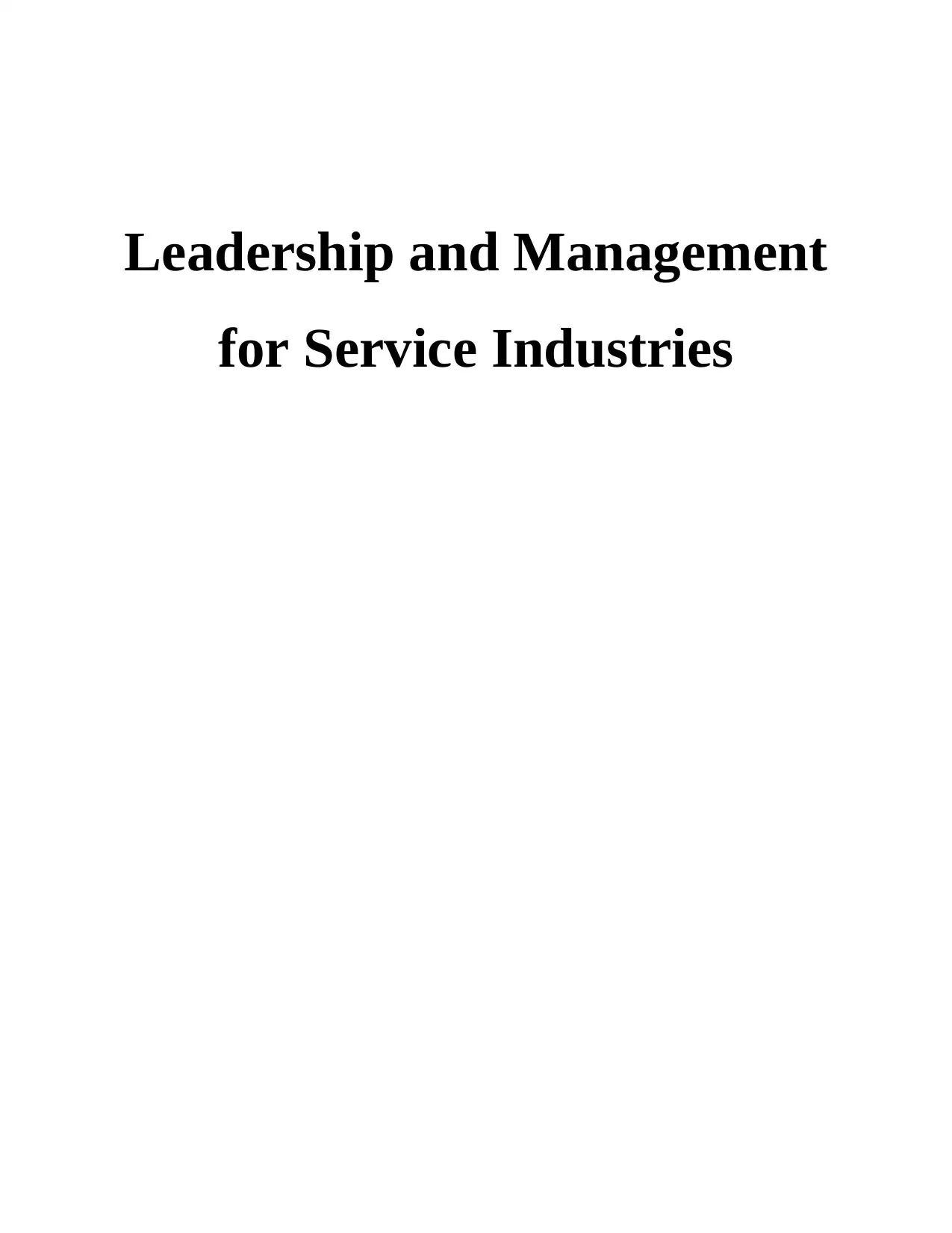
Leadership and Management
for Service Industries
for Service Industries
Paraphrase This Document
Need a fresh take? Get an instant paraphrase of this document with our AI Paraphraser
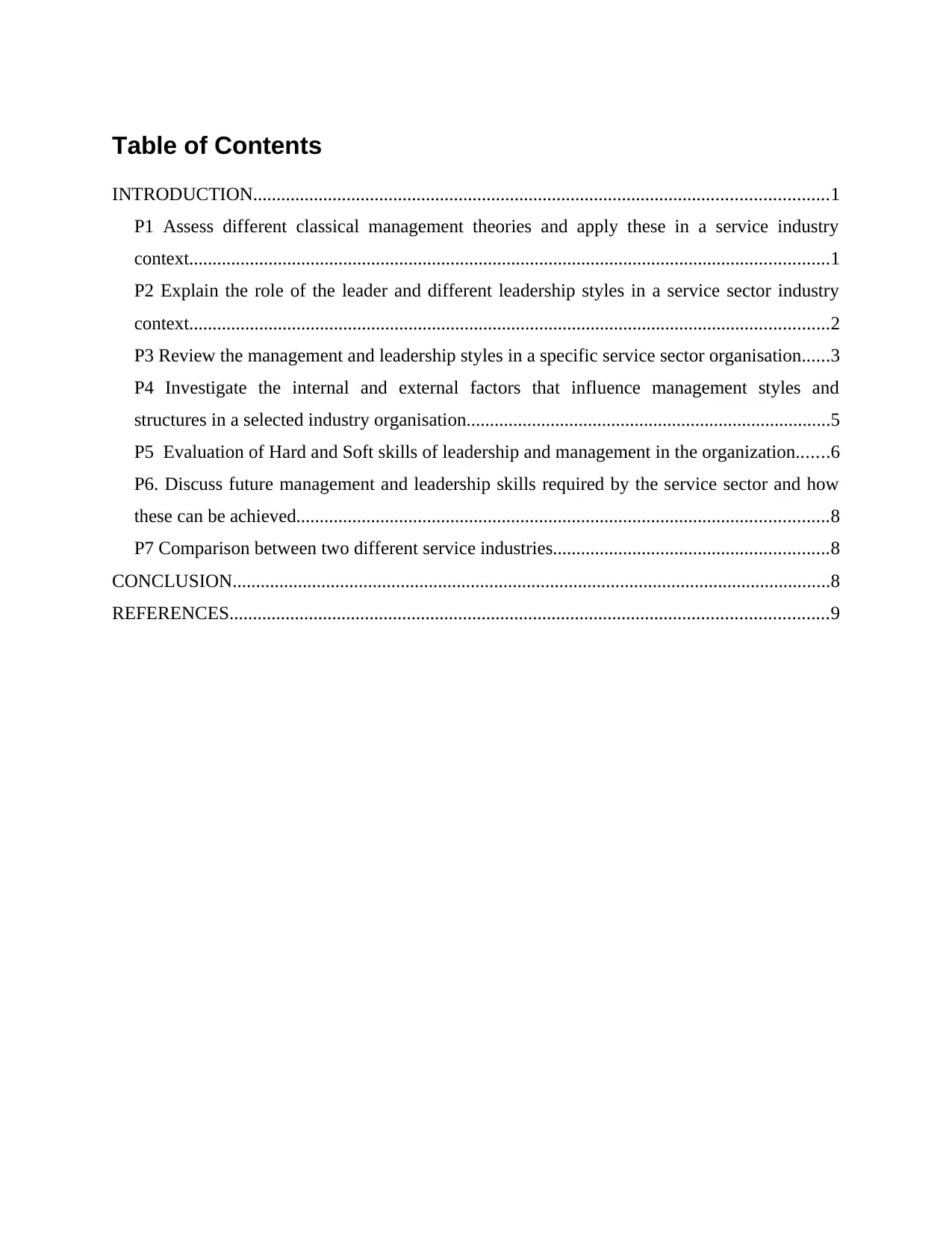
Table of Contents
INTRODUCTION...........................................................................................................................1
P1 Assess different classical management theories and apply these in a service industry
context.........................................................................................................................................1
P2 Explain the role of the leader and different leadership styles in a service sector industry
context.........................................................................................................................................2
P3 Review the management and leadership styles in a specific service sector organisation......3
P4 Investigate the internal and external factors that influence management styles and
structures in a selected industry organisation..............................................................................5
P5 Evaluation of Hard and Soft skills of leadership and management in the organization.......6
P6. Discuss future management and leadership skills required by the service sector and how
these can be achieved..................................................................................................................8
P7 Comparison between two different service industries...........................................................8
CONCLUSION................................................................................................................................8
REFERENCES................................................................................................................................9
INTRODUCTION...........................................................................................................................1
P1 Assess different classical management theories and apply these in a service industry
context.........................................................................................................................................1
P2 Explain the role of the leader and different leadership styles in a service sector industry
context.........................................................................................................................................2
P3 Review the management and leadership styles in a specific service sector organisation......3
P4 Investigate the internal and external factors that influence management styles and
structures in a selected industry organisation..............................................................................5
P5 Evaluation of Hard and Soft skills of leadership and management in the organization.......6
P6. Discuss future management and leadership skills required by the service sector and how
these can be achieved..................................................................................................................8
P7 Comparison between two different service industries...........................................................8
CONCLUSION................................................................................................................................8
REFERENCES................................................................................................................................9
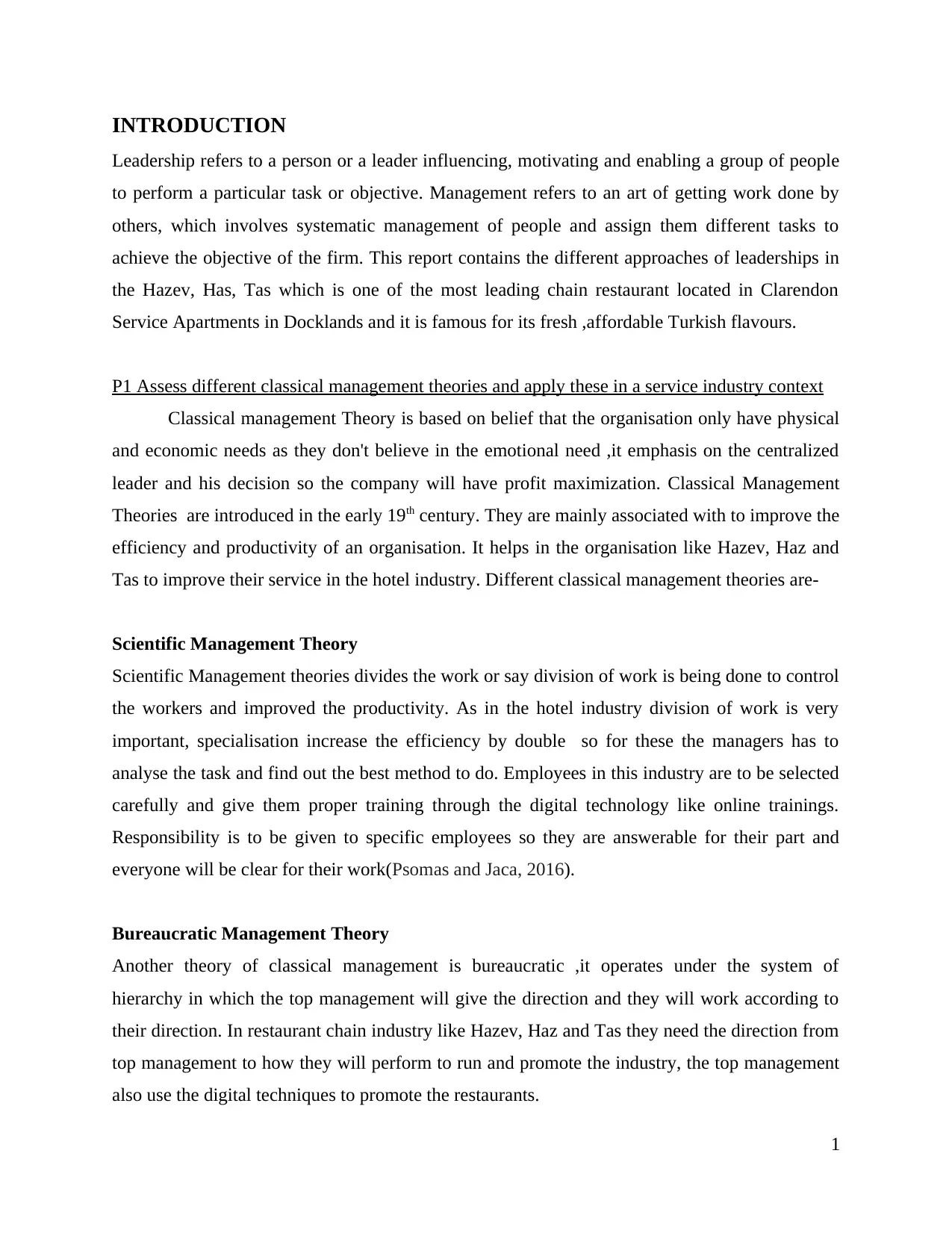
INTRODUCTION
Leadership refers to a person or a leader influencing, motivating and enabling a group of people
to perform a particular task or objective. Management refers to an art of getting work done by
others, which involves systematic management of people and assign them different tasks to
achieve the objective of the firm. This report contains the different approaches of leaderships in
the Hazev, Has, Tas which is one of the most leading chain restaurant located in Clarendon
Service Apartments in Docklands and it is famous for its fresh ,affordable Turkish flavours.
P1 Assess different classical management theories and apply these in a service industry context
Classical management Theory is based on belief that the organisation only have physical
and economic needs as they don't believe in the emotional need ,it emphasis on the centralized
leader and his decision so the company will have profit maximization. Classical Management
Theories are introduced in the early 19th century. They are mainly associated with to improve the
efficiency and productivity of an organisation. It helps in the organisation like Hazev, Haz and
Tas to improve their service in the hotel industry. Different classical management theories are-
Scientific Management Theory
Scientific Management theories divides the work or say division of work is being done to control
the workers and improved the productivity. As in the hotel industry division of work is very
important, specialisation increase the efficiency by double so for these the managers has to
analyse the task and find out the best method to do. Employees in this industry are to be selected
carefully and give them proper training through the digital technology like online trainings.
Responsibility is to be given to specific employees so they are answerable for their part and
everyone will be clear for their work(Psomas and Jaca, 2016).
Bureaucratic Management Theory
Another theory of classical management is bureaucratic ,it operates under the system of
hierarchy in which the top management will give the direction and they will work according to
their direction. In restaurant chain industry like Hazev, Haz and Tas they need the direction from
top management to how they will perform to run and promote the industry, the top management
also use the digital techniques to promote the restaurants.
1
Leadership refers to a person or a leader influencing, motivating and enabling a group of people
to perform a particular task or objective. Management refers to an art of getting work done by
others, which involves systematic management of people and assign them different tasks to
achieve the objective of the firm. This report contains the different approaches of leaderships in
the Hazev, Has, Tas which is one of the most leading chain restaurant located in Clarendon
Service Apartments in Docklands and it is famous for its fresh ,affordable Turkish flavours.
P1 Assess different classical management theories and apply these in a service industry context
Classical management Theory is based on belief that the organisation only have physical
and economic needs as they don't believe in the emotional need ,it emphasis on the centralized
leader and his decision so the company will have profit maximization. Classical Management
Theories are introduced in the early 19th century. They are mainly associated with to improve the
efficiency and productivity of an organisation. It helps in the organisation like Hazev, Haz and
Tas to improve their service in the hotel industry. Different classical management theories are-
Scientific Management Theory
Scientific Management theories divides the work or say division of work is being done to control
the workers and improved the productivity. As in the hotel industry division of work is very
important, specialisation increase the efficiency by double so for these the managers has to
analyse the task and find out the best method to do. Employees in this industry are to be selected
carefully and give them proper training through the digital technology like online trainings.
Responsibility is to be given to specific employees so they are answerable for their part and
everyone will be clear for their work(Psomas and Jaca, 2016).
Bureaucratic Management Theory
Another theory of classical management is bureaucratic ,it operates under the system of
hierarchy in which the top management will give the direction and they will work according to
their direction. In restaurant chain industry like Hazev, Haz and Tas they need the direction from
top management to how they will perform to run and promote the industry, the top management
also use the digital techniques to promote the restaurants.
1
⊘ This is a preview!⊘
Do you want full access?
Subscribe today to unlock all pages.

Trusted by 1+ million students worldwide
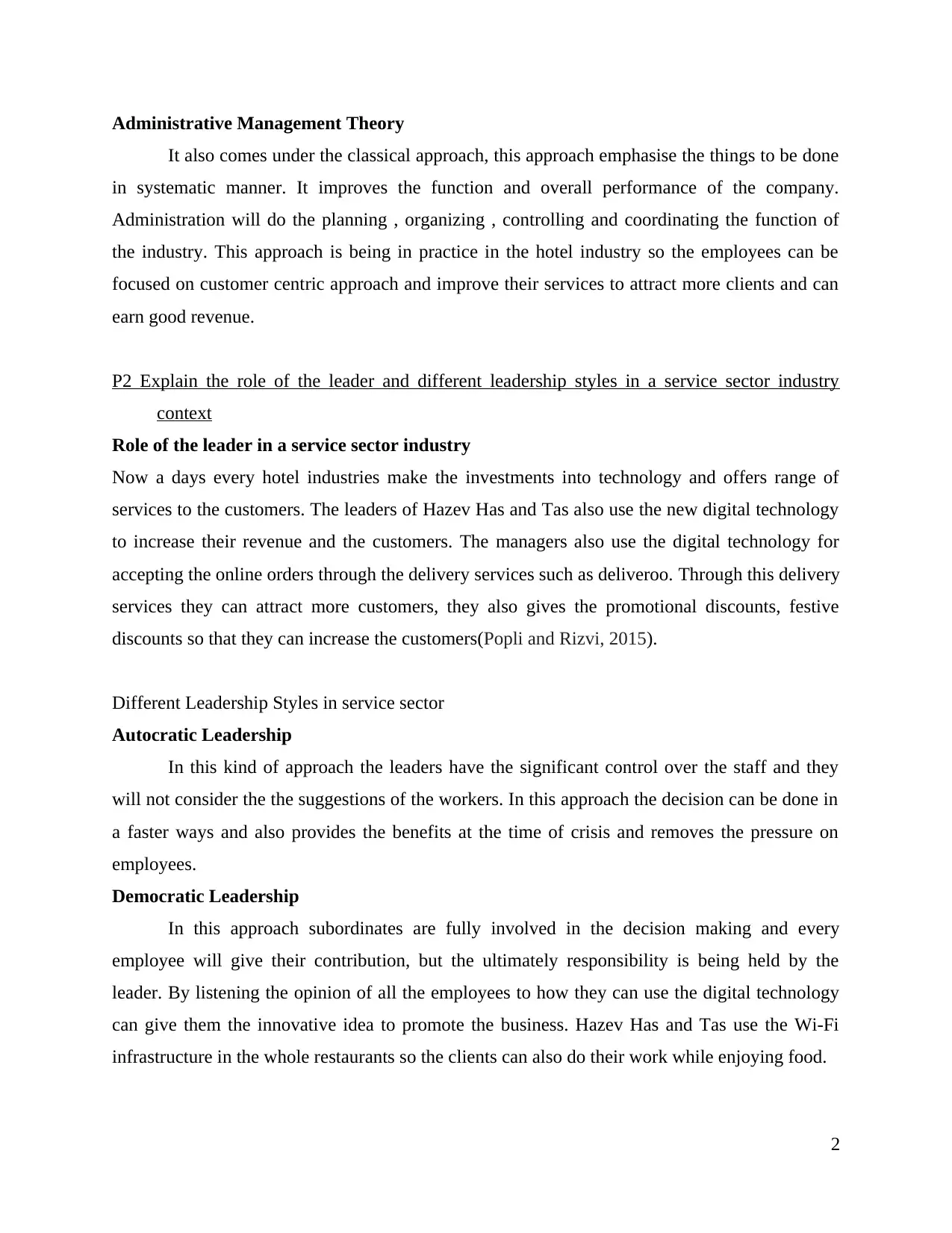
Administrative Management Theory
It also comes under the classical approach, this approach emphasise the things to be done
in systematic manner. It improves the function and overall performance of the company.
Administration will do the planning , organizing , controlling and coordinating the function of
the industry. This approach is being in practice in the hotel industry so the employees can be
focused on customer centric approach and improve their services to attract more clients and can
earn good revenue.
P2 Explain the role of the leader and different leadership styles in a service sector industry
context
Role of the leader in a service sector industry
Now a days every hotel industries make the investments into technology and offers range of
services to the customers. The leaders of Hazev Has and Tas also use the new digital technology
to increase their revenue and the customers. The managers also use the digital technology for
accepting the online orders through the delivery services such as deliveroo. Through this delivery
services they can attract more customers, they also gives the promotional discounts, festive
discounts so that they can increase the customers(Popli and Rizvi, 2015).
Different Leadership Styles in service sector
Autocratic Leadership
In this kind of approach the leaders have the significant control over the staff and they
will not consider the the suggestions of the workers. In this approach the decision can be done in
a faster ways and also provides the benefits at the time of crisis and removes the pressure on
employees.
Democratic Leadership
In this approach subordinates are fully involved in the decision making and every
employee will give their contribution, but the ultimately responsibility is being held by the
leader. By listening the opinion of all the employees to how they can use the digital technology
can give them the innovative idea to promote the business. Hazev Has and Tas use the Wi-Fi
infrastructure in the whole restaurants so the clients can also do their work while enjoying food.
2
It also comes under the classical approach, this approach emphasise the things to be done
in systematic manner. It improves the function and overall performance of the company.
Administration will do the planning , organizing , controlling and coordinating the function of
the industry. This approach is being in practice in the hotel industry so the employees can be
focused on customer centric approach and improve their services to attract more clients and can
earn good revenue.
P2 Explain the role of the leader and different leadership styles in a service sector industry
context
Role of the leader in a service sector industry
Now a days every hotel industries make the investments into technology and offers range of
services to the customers. The leaders of Hazev Has and Tas also use the new digital technology
to increase their revenue and the customers. The managers also use the digital technology for
accepting the online orders through the delivery services such as deliveroo. Through this delivery
services they can attract more customers, they also gives the promotional discounts, festive
discounts so that they can increase the customers(Popli and Rizvi, 2015).
Different Leadership Styles in service sector
Autocratic Leadership
In this kind of approach the leaders have the significant control over the staff and they
will not consider the the suggestions of the workers. In this approach the decision can be done in
a faster ways and also provides the benefits at the time of crisis and removes the pressure on
employees.
Democratic Leadership
In this approach subordinates are fully involved in the decision making and every
employee will give their contribution, but the ultimately responsibility is being held by the
leader. By listening the opinion of all the employees to how they can use the digital technology
can give them the innovative idea to promote the business. Hazev Has and Tas use the Wi-Fi
infrastructure in the whole restaurants so the clients can also do their work while enjoying food.
2
Paraphrase This Document
Need a fresh take? Get an instant paraphrase of this document with our AI Paraphraser
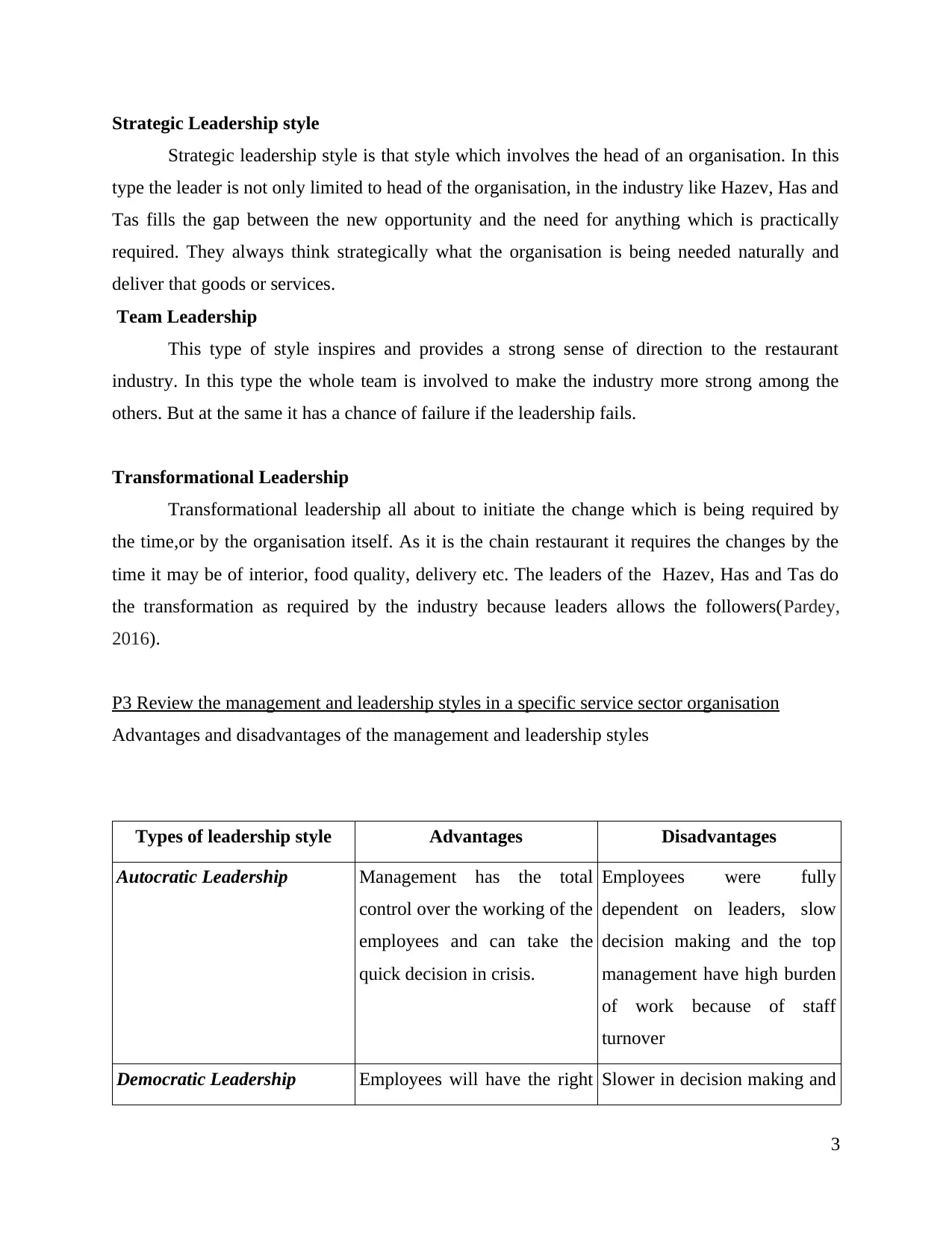
Strategic Leadership style
Strategic leadership style is that style which involves the head of an organisation. In this
type the leader is not only limited to head of the organisation, in the industry like Hazev, Has and
Tas fills the gap between the new opportunity and the need for anything which is practically
required. They always think strategically what the organisation is being needed naturally and
deliver that goods or services.
Team Leadership
This type of style inspires and provides a strong sense of direction to the restaurant
industry. In this type the whole team is involved to make the industry more strong among the
others. But at the same it has a chance of failure if the leadership fails.
Transformational Leadership
Transformational leadership all about to initiate the change which is being required by
the time,or by the organisation itself. As it is the chain restaurant it requires the changes by the
time it may be of interior, food quality, delivery etc. The leaders of the Hazev, Has and Tas do
the transformation as required by the industry because leaders allows the followers(Pardey,
2016).
P3 Review the management and leadership styles in a specific service sector organisation
Advantages and disadvantages of the management and leadership styles
Types of leadership style Advantages Disadvantages
Autocratic Leadership Management has the total
control over the working of the
employees and can take the
quick decision in crisis.
Employees were fully
dependent on leaders, slow
decision making and the top
management have high burden
of work because of staff
turnover
Democratic Leadership Employees will have the right Slower in decision making and
3
Strategic leadership style is that style which involves the head of an organisation. In this
type the leader is not only limited to head of the organisation, in the industry like Hazev, Has and
Tas fills the gap between the new opportunity and the need for anything which is practically
required. They always think strategically what the organisation is being needed naturally and
deliver that goods or services.
Team Leadership
This type of style inspires and provides a strong sense of direction to the restaurant
industry. In this type the whole team is involved to make the industry more strong among the
others. But at the same it has a chance of failure if the leadership fails.
Transformational Leadership
Transformational leadership all about to initiate the change which is being required by
the time,or by the organisation itself. As it is the chain restaurant it requires the changes by the
time it may be of interior, food quality, delivery etc. The leaders of the Hazev, Has and Tas do
the transformation as required by the industry because leaders allows the followers(Pardey,
2016).
P3 Review the management and leadership styles in a specific service sector organisation
Advantages and disadvantages of the management and leadership styles
Types of leadership style Advantages Disadvantages
Autocratic Leadership Management has the total
control over the working of the
employees and can take the
quick decision in crisis.
Employees were fully
dependent on leaders, slow
decision making and the top
management have high burden
of work because of staff
turnover
Democratic Leadership Employees will have the right Slower in decision making and
3
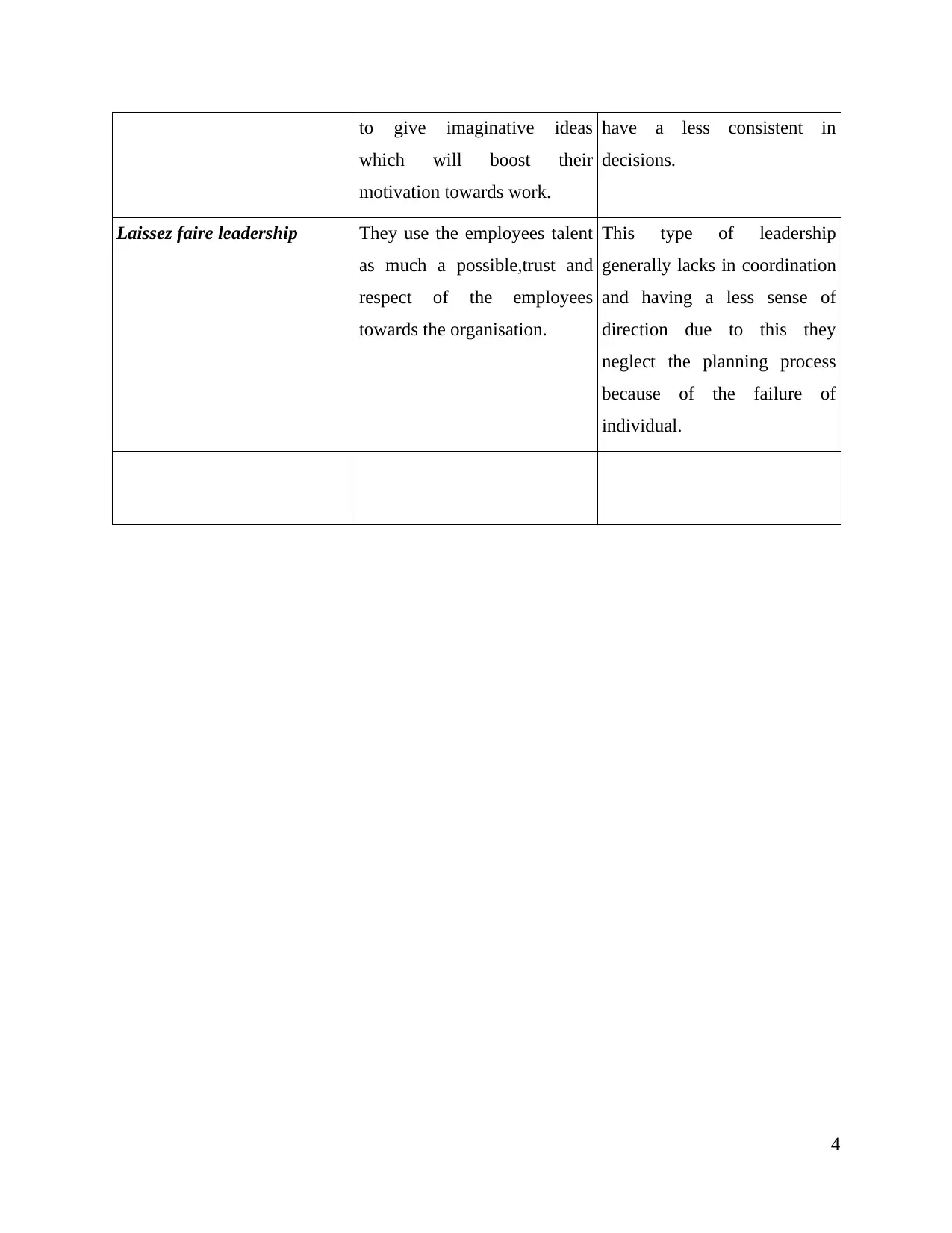
to give imaginative ideas
which will boost their
motivation towards work.
have a less consistent in
decisions.
Laissez faire leadership They use the employees talent
as much a possible,trust and
respect of the employees
towards the organisation.
This type of leadership
generally lacks in coordination
and having a less sense of
direction due to this they
neglect the planning process
because of the failure of
individual.
4
which will boost their
motivation towards work.
have a less consistent in
decisions.
Laissez faire leadership They use the employees talent
as much a possible,trust and
respect of the employees
towards the organisation.
This type of leadership
generally lacks in coordination
and having a less sense of
direction due to this they
neglect the planning process
because of the failure of
individual.
4
⊘ This is a preview!⊘
Do you want full access?
Subscribe today to unlock all pages.

Trusted by 1+ million students worldwide
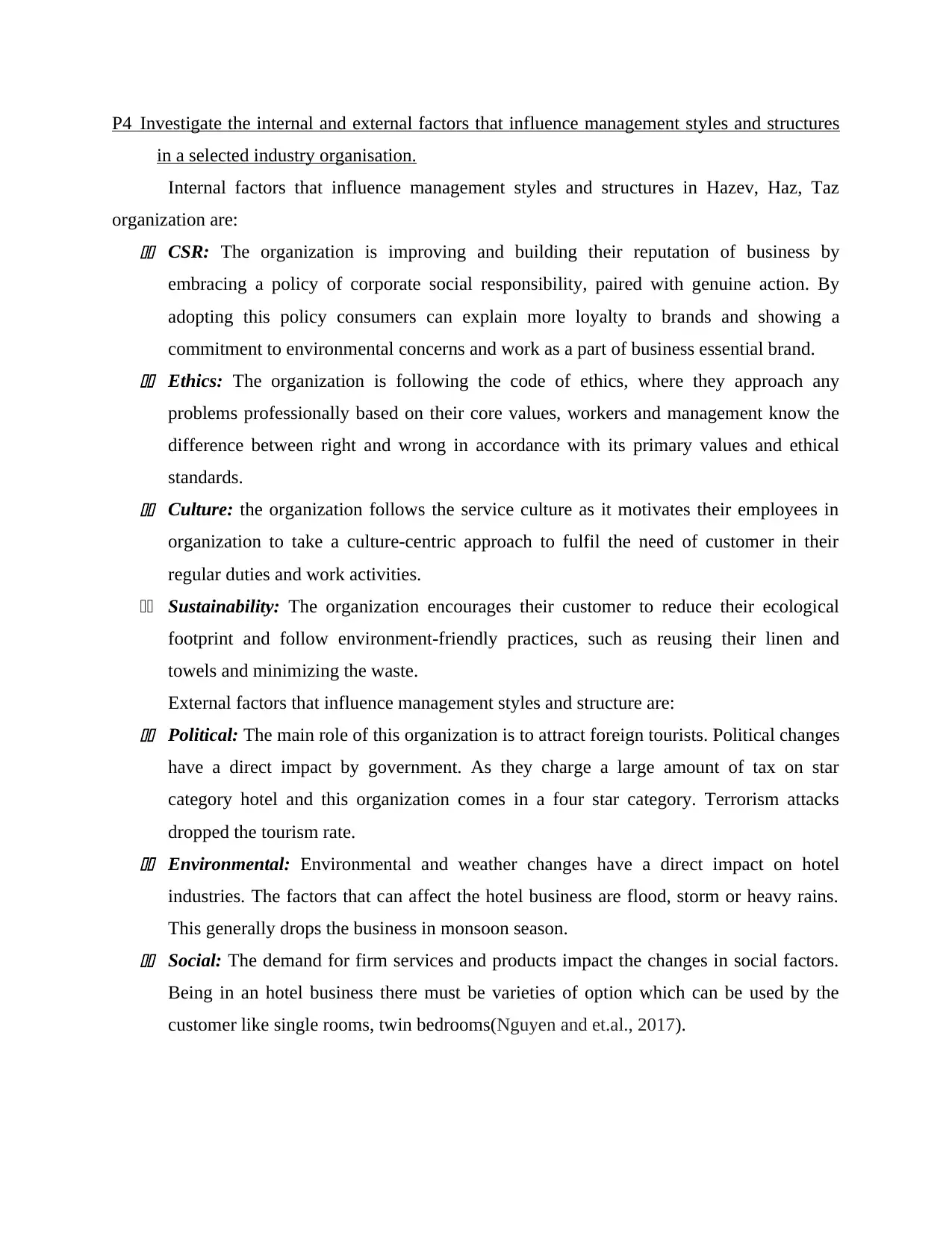
P4 Investigate the internal and external factors that influence management styles and structures
in a selected industry organisation.
Internal factors that influence management styles and structures in Hazev, Haz, Taz
organization are:11 CSR: The organization is improving and building their reputation of business by
embracing a policy of corporate social responsibility, paired with genuine action. By
adopting this policy consumers can explain more loyalty to brands and showing a
commitment to environmental concerns and work as a part of business essential brand.11 Ethics: The organization is following the code of ethics, where they approach any
problems professionally based on their core values, workers and management know the
difference between right and wrong in accordance with its primary values and ethical
standards.11 Culture: the organization follows the service culture as it motivates their employees in
organization to take a culture-centric approach to fulfil the need of customer in their
regular duties and work activities.
11 Sustainability: The organization encourages their customer to reduce their ecological
footprint and follow environment-friendly practices, such as reusing their linen and
towels and minimizing the waste.
External factors that influence management styles and structure are:11 Political: The main role of this organization is to attract foreign tourists. Political changes
have a direct impact by government. As they charge a large amount of tax on star
category hotel and this organization comes in a four star category. Terrorism attacks
dropped the tourism rate.11 Environmental: Environmental and weather changes have a direct impact on hotel
industries. The factors that can affect the hotel business are flood, storm or heavy rains.
This generally drops the business in monsoon season.11 Social: The demand for firm services and products impact the changes in social factors.
Being in an hotel business there must be varieties of option which can be used by the
customer like single rooms, twin bedrooms(Nguyen and et.al., 2017).
in a selected industry organisation.
Internal factors that influence management styles and structures in Hazev, Haz, Taz
organization are:11 CSR: The organization is improving and building their reputation of business by
embracing a policy of corporate social responsibility, paired with genuine action. By
adopting this policy consumers can explain more loyalty to brands and showing a
commitment to environmental concerns and work as a part of business essential brand.11 Ethics: The organization is following the code of ethics, where they approach any
problems professionally based on their core values, workers and management know the
difference between right and wrong in accordance with its primary values and ethical
standards.11 Culture: the organization follows the service culture as it motivates their employees in
organization to take a culture-centric approach to fulfil the need of customer in their
regular duties and work activities.
11 Sustainability: The organization encourages their customer to reduce their ecological
footprint and follow environment-friendly practices, such as reusing their linen and
towels and minimizing the waste.
External factors that influence management styles and structure are:11 Political: The main role of this organization is to attract foreign tourists. Political changes
have a direct impact by government. As they charge a large amount of tax on star
category hotel and this organization comes in a four star category. Terrorism attacks
dropped the tourism rate.11 Environmental: Environmental and weather changes have a direct impact on hotel
industries. The factors that can affect the hotel business are flood, storm or heavy rains.
This generally drops the business in monsoon season.11 Social: The demand for firm services and products impact the changes in social factors.
Being in an hotel business there must be varieties of option which can be used by the
customer like single rooms, twin bedrooms(Nguyen and et.al., 2017).
Paraphrase This Document
Need a fresh take? Get an instant paraphrase of this document with our AI Paraphraser
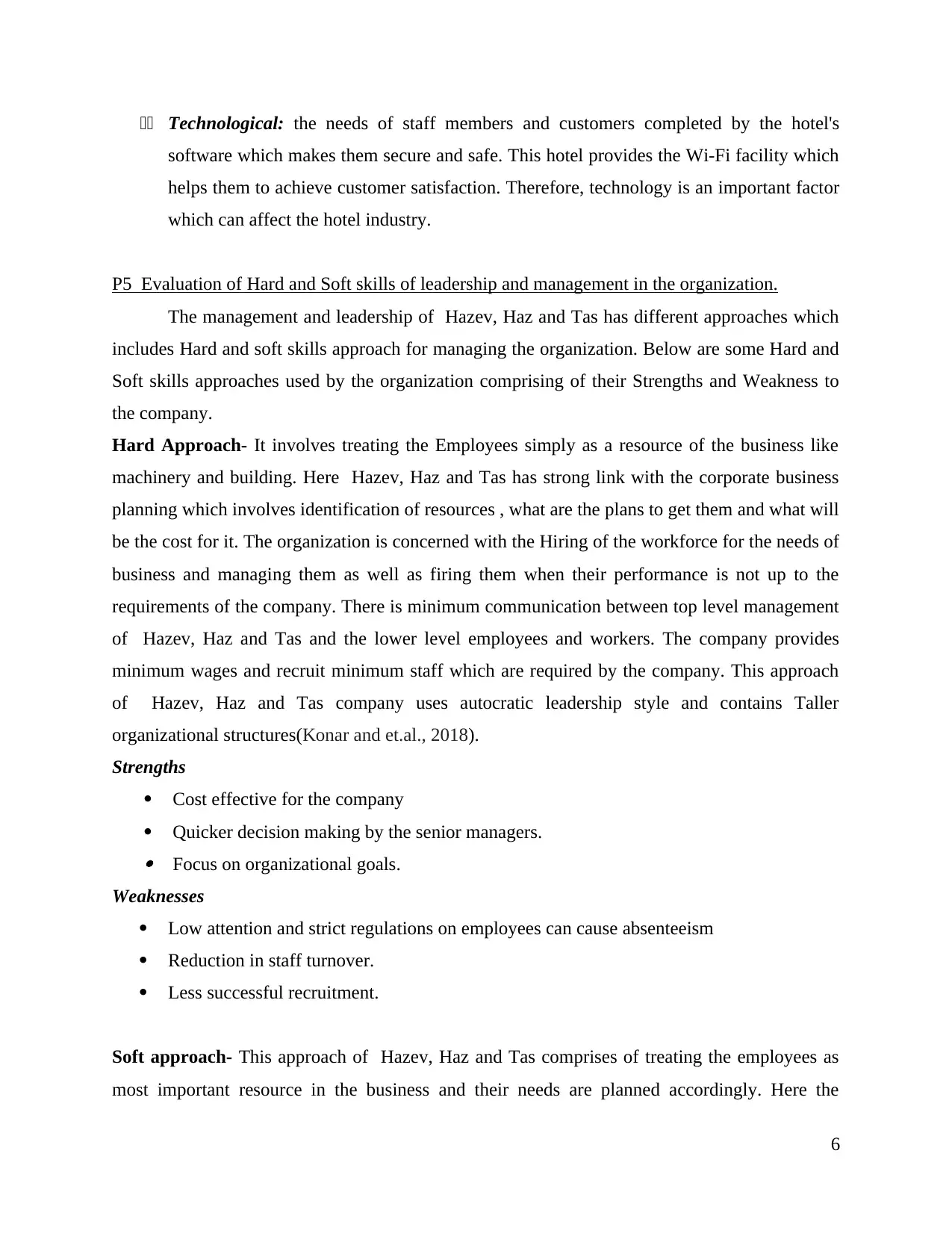
11 Technological: the needs of staff members and customers completed by the hotel's
software which makes them secure and safe. This hotel provides the Wi-Fi facility which
helps them to achieve customer satisfaction. Therefore, technology is an important factor
which can affect the hotel industry.
P5 Evaluation of Hard and Soft skills of leadership and management in the organization.
The management and leadership of Hazev, Haz and Tas has different approaches which
includes Hard and soft skills approach for managing the organization. Below are some Hard and
Soft skills approaches used by the organization comprising of their Strengths and Weakness to
the company.
Hard Approach- It involves treating the Employees simply as a resource of the business like
machinery and building. Here Hazev, Haz and Tas has strong link with the corporate business
planning which involves identification of resources , what are the plans to get them and what will
be the cost for it. The organization is concerned with the Hiring of the workforce for the needs of
business and managing them as well as firing them when their performance is not up to the
requirements of the company. There is minimum communication between top level management
of Hazev, Haz and Tas and the lower level employees and workers. The company provides
minimum wages and recruit minimum staff which are required by the company. This approach
of Hazev, Haz and Tas company uses autocratic leadership style and contains Taller
organizational structures(Konar and et.al., 2018).
Strengths
Cost effective for the company
Quicker decision making by the senior managers. Focus on organizational goals.
Weaknesses
Low attention and strict regulations on employees can cause absenteeism
Reduction in staff turnover.
Less successful recruitment.
Soft approach- This approach of Hazev, Haz and Tas comprises of treating the employees as
most important resource in the business and their needs are planned accordingly. Here the
6
software which makes them secure and safe. This hotel provides the Wi-Fi facility which
helps them to achieve customer satisfaction. Therefore, technology is an important factor
which can affect the hotel industry.
P5 Evaluation of Hard and Soft skills of leadership and management in the organization.
The management and leadership of Hazev, Haz and Tas has different approaches which
includes Hard and soft skills approach for managing the organization. Below are some Hard and
Soft skills approaches used by the organization comprising of their Strengths and Weakness to
the company.
Hard Approach- It involves treating the Employees simply as a resource of the business like
machinery and building. Here Hazev, Haz and Tas has strong link with the corporate business
planning which involves identification of resources , what are the plans to get them and what will
be the cost for it. The organization is concerned with the Hiring of the workforce for the needs of
business and managing them as well as firing them when their performance is not up to the
requirements of the company. There is minimum communication between top level management
of Hazev, Haz and Tas and the lower level employees and workers. The company provides
minimum wages and recruit minimum staff which are required by the company. This approach
of Hazev, Haz and Tas company uses autocratic leadership style and contains Taller
organizational structures(Konar and et.al., 2018).
Strengths
Cost effective for the company
Quicker decision making by the senior managers. Focus on organizational goals.
Weaknesses
Low attention and strict regulations on employees can cause absenteeism
Reduction in staff turnover.
Less successful recruitment.
Soft approach- This approach of Hazev, Haz and Tas comprises of treating the employees as
most important resource in the business and their needs are planned accordingly. Here the
6
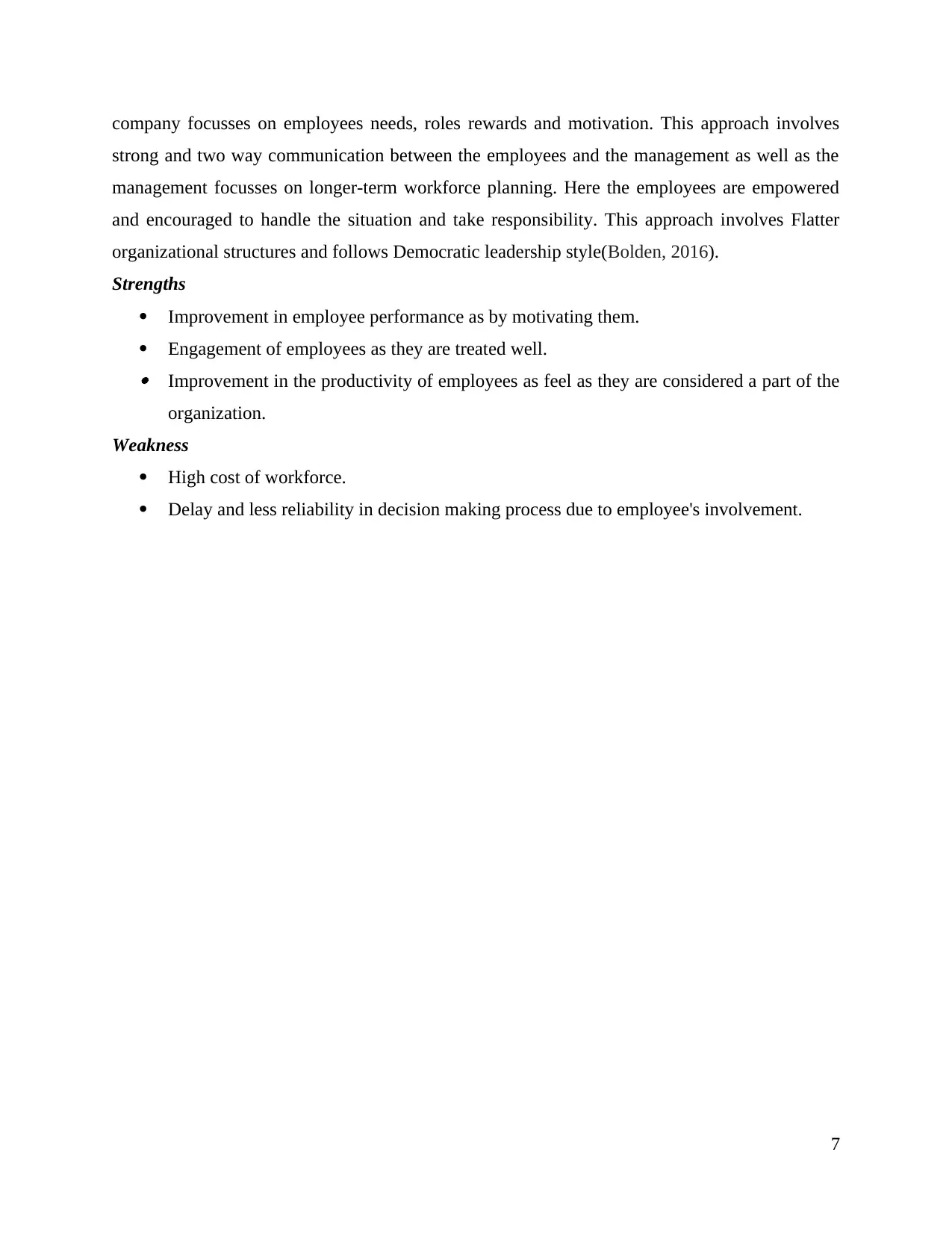
company focusses on employees needs, roles rewards and motivation. This approach involves
strong and two way communication between the employees and the management as well as the
management focusses on longer-term workforce planning. Here the employees are empowered
and encouraged to handle the situation and take responsibility. This approach involves Flatter
organizational structures and follows Democratic leadership style(Bolden, 2016).
Strengths
Improvement in employee performance as by motivating them.
Engagement of employees as they are treated well. Improvement in the productivity of employees as feel as they are considered a part of the
organization.
Weakness
High cost of workforce.
Delay and less reliability in decision making process due to employee's involvement.
7
strong and two way communication between the employees and the management as well as the
management focusses on longer-term workforce planning. Here the employees are empowered
and encouraged to handle the situation and take responsibility. This approach involves Flatter
organizational structures and follows Democratic leadership style(Bolden, 2016).
Strengths
Improvement in employee performance as by motivating them.
Engagement of employees as they are treated well. Improvement in the productivity of employees as feel as they are considered a part of the
organization.
Weakness
High cost of workforce.
Delay and less reliability in decision making process due to employee's involvement.
7
⊘ This is a preview!⊘
Do you want full access?
Subscribe today to unlock all pages.

Trusted by 1+ million students worldwide
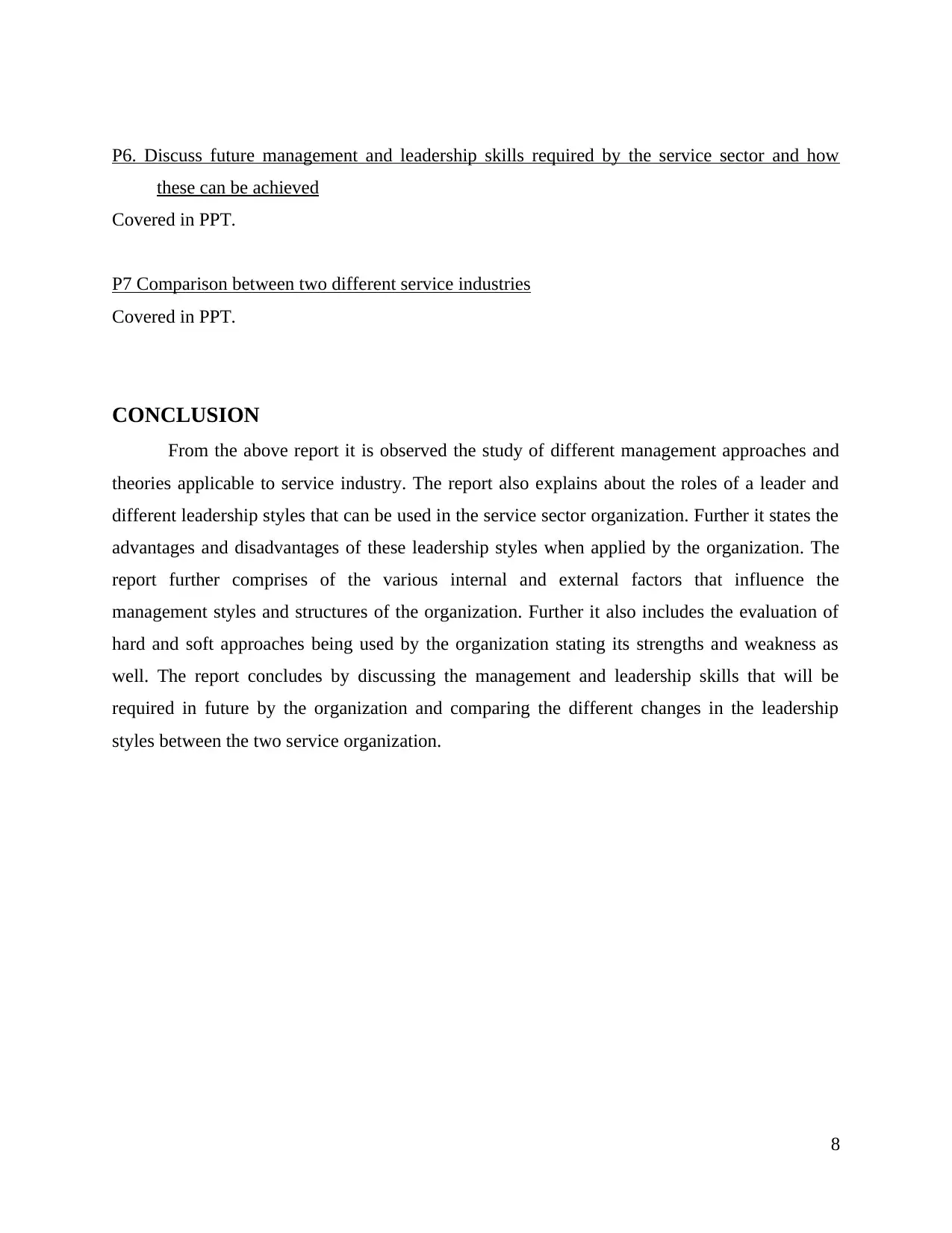
P6. Discuss future management and leadership skills required by the service sector and how
these can be achieved
Covered in PPT.
P7 Comparison between two different service industries
Covered in PPT.
CONCLUSION
From the above report it is observed the study of different management approaches and
theories applicable to service industry. The report also explains about the roles of a leader and
different leadership styles that can be used in the service sector organization. Further it states the
advantages and disadvantages of these leadership styles when applied by the organization. The
report further comprises of the various internal and external factors that influence the
management styles and structures of the organization. Further it also includes the evaluation of
hard and soft approaches being used by the organization stating its strengths and weakness as
well. The report concludes by discussing the management and leadership skills that will be
required in future by the organization and comparing the different changes in the leadership
styles between the two service organization.
8
these can be achieved
Covered in PPT.
P7 Comparison between two different service industries
Covered in PPT.
CONCLUSION
From the above report it is observed the study of different management approaches and
theories applicable to service industry. The report also explains about the roles of a leader and
different leadership styles that can be used in the service sector organization. Further it states the
advantages and disadvantages of these leadership styles when applied by the organization. The
report further comprises of the various internal and external factors that influence the
management styles and structures of the organization. Further it also includes the evaluation of
hard and soft approaches being used by the organization stating its strengths and weakness as
well. The report concludes by discussing the management and leadership skills that will be
required in future by the organization and comparing the different changes in the leadership
styles between the two service organization.
8
Paraphrase This Document
Need a fresh take? Get an instant paraphrase of this document with our AI Paraphraser
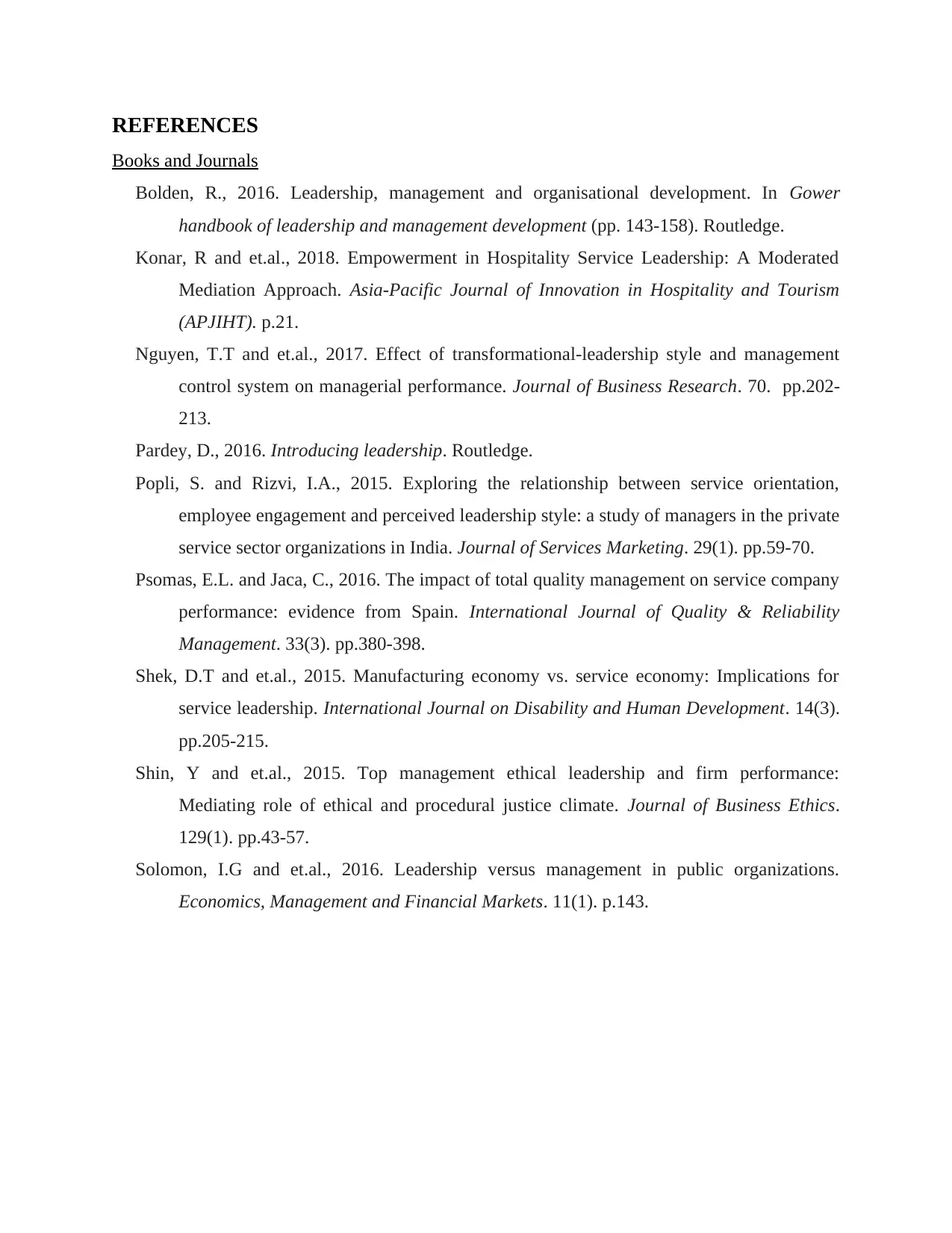
REFERENCES
Books and Journals
Bolden, R., 2016. Leadership, management and organisational development. In Gower
handbook of leadership and management development (pp. 143-158). Routledge.
Konar, R and et.al., 2018. Empowerment in Hospitality Service Leadership: A Moderated
Mediation Approach. Asia-Pacific Journal of Innovation in Hospitality and Tourism
(APJIHT). p.21.
Nguyen, T.T and et.al., 2017. Effect of transformational-leadership style and management
control system on managerial performance. Journal of Business Research. 70. pp.202-
213.
Pardey, D., 2016. Introducing leadership. Routledge.
Popli, S. and Rizvi, I.A., 2015. Exploring the relationship between service orientation,
employee engagement and perceived leadership style: a study of managers in the private
service sector organizations in India. Journal of Services Marketing. 29(1). pp.59-70.
Psomas, E.L. and Jaca, C., 2016. The impact of total quality management on service company
performance: evidence from Spain. International Journal of Quality & Reliability
Management. 33(3). pp.380-398.
Shek, D.T and et.al., 2015. Manufacturing economy vs. service economy: Implications for
service leadership. International Journal on Disability and Human Development. 14(3).
pp.205-215.
Shin, Y and et.al., 2015. Top management ethical leadership and firm performance:
Mediating role of ethical and procedural justice climate. Journal of Business Ethics.
129(1). pp.43-57.
Solomon, I.G and et.al., 2016. Leadership versus management in public organizations.
Economics, Management and Financial Markets. 11(1). p.143.
Books and Journals
Bolden, R., 2016. Leadership, management and organisational development. In Gower
handbook of leadership and management development (pp. 143-158). Routledge.
Konar, R and et.al., 2018. Empowerment in Hospitality Service Leadership: A Moderated
Mediation Approach. Asia-Pacific Journal of Innovation in Hospitality and Tourism
(APJIHT). p.21.
Nguyen, T.T and et.al., 2017. Effect of transformational-leadership style and management
control system on managerial performance. Journal of Business Research. 70. pp.202-
213.
Pardey, D., 2016. Introducing leadership. Routledge.
Popli, S. and Rizvi, I.A., 2015. Exploring the relationship between service orientation,
employee engagement and perceived leadership style: a study of managers in the private
service sector organizations in India. Journal of Services Marketing. 29(1). pp.59-70.
Psomas, E.L. and Jaca, C., 2016. The impact of total quality management on service company
performance: evidence from Spain. International Journal of Quality & Reliability
Management. 33(3). pp.380-398.
Shek, D.T and et.al., 2015. Manufacturing economy vs. service economy: Implications for
service leadership. International Journal on Disability and Human Development. 14(3).
pp.205-215.
Shin, Y and et.al., 2015. Top management ethical leadership and firm performance:
Mediating role of ethical and procedural justice climate. Journal of Business Ethics.
129(1). pp.43-57.
Solomon, I.G and et.al., 2016. Leadership versus management in public organizations.
Economics, Management and Financial Markets. 11(1). p.143.
1 out of 11
Related Documents
Your All-in-One AI-Powered Toolkit for Academic Success.
+13062052269
info@desklib.com
Available 24*7 on WhatsApp / Email
![[object Object]](/_next/static/media/star-bottom.7253800d.svg)
Unlock your academic potential
Copyright © 2020–2025 A2Z Services. All Rights Reserved. Developed and managed by ZUCOL.





